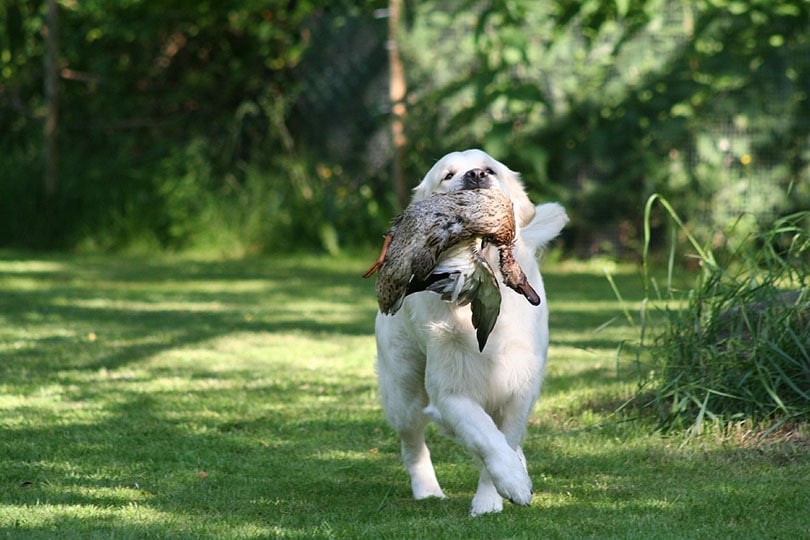Click to Skip Ahead
Labradors are the most popular dog in America and have been for around 30 years. This breed’s loving, fun personalities have endeared them to many, and they’re well-known for the three colors they typically come in; yellow, black, and chocolate. You may not have been aware of this, but they also come in white.
Breed Overview
Height:
21 – 25 inches
Weight:
55 – 80 pounds
Lifespan:
10 – 12 years
Colors:
black, yellow, chocolate
Suitable for:
Families looking for a loyal dog that is eager to please and energetic
Temperament:
Calm, affectionate, energetic, intelligent, loyal
Here’s what you need to know about the white Labrador.
Labrador Retriever Characteristics
The Earliest Records of White Labrador Retrievers in History
Labradors have been around since the breed began being developed in Newfoundland in the 16th century. However, white Labs have only existed as outliers for most of this breed’s history. It wasn’t until the last few decades that people began breeding with the specific intent of creating lines of white Labs. Although the coat is beautiful, it can be difficult to achieve by accident, so it took many years of selective breeding to establish lines of white Labs.

How White Labrador Retrievers Gained Popularity
Although some breeds and colors achieve popularity because they make an appearance in media of some sort, this isn’t the case for the white Lab. These dogs aren’t overly popular at this point in time, and they aren’t particularly numerous either. There are only a few breeders who are breeding for this color, and even fewer of them are responsible breeders who practice good breeding practices with health-tested dogs.
Formal Recognition of White Labrador Retrievers
White Labs are purebred dogs that are formally recognized by the American Kennel Club (AKC). However, they fall under the “yellow” category for registration and showing purposes. They are considered to be a pale yellow coloration, not a true white. In most cases, white Labs have yellow or cream coloration around the face and ears.
They should have pigment in their eyes and noses, though, much like yellow Labs do. While the white color falls under the yellow color umbrella, it is entirely different from albinism. Albino dogs lack pigment, even in the eyes and nose, and they are not accepted under the breed standard of Labradors.

Top 5 Unique Facts About the White Labrador Retriever
1. They’re just a variation of yellow Labs.
White labs are essentially dilute yellow Labs. In fact, many of them will take on yellow or cream coloration, especially after spending a lot of time in the sun.
2. White is more common in English Labs than in American Labs
Although they are the same breed, English Labs are typically considered to be more show worthy, while American Labs are prized as working dogs. English Labs tend to be stockier but lighter than their taller, heavier American counterparts.
3. White coloration in Labs comes from a recessive gene
Both parents of a white Lab must have the genes that allow for white coloration to occur.

4. Their coat is the same type as other Lab colors
Although their colors differ, white Labs still have the short double coat that other Labs have. This means they tend to be big shedders, with some anecdotal evidence that white Labs may shed a little more than other colors do.
5. White puppies may not stay white
Often, puppies are lighter at birth than they will be once they start growing. It’s not uncommon for puppies to be born white but to darken over time, eventually turning into true yellow Labs.
Do White Labrador Retrievers Make a Good Pet?
Labradors as a whole are a fantastic dog breed, which is easily proven by how popular this breed has remained for decades. These are intelligent and personable dogs known for their love of people and gentle nature. They tend to be good with children, and many people prize Labs for hunting and retrieving purposes. They’re athletic dogs that can excel at a variety of canine sports, including obedience, agility, and dock diving. White Labs are just as athletic and healthy as their yellow, black, and chocolate counterparts.
Conclusion
White Labs are an accepted part of the Labrador breed, although they are considered to be a dilute yellow. Even still, they are highly prized, even within the show world. They retain the desirable traits of other Labrador colors, like excellent temperament, intelligence, and trainability, but there are no known medical conditions associated with the white color. This means that your white Lab should be just as healthy as the other acceptable colors within the breed. They are athletic dogs that sport a beautiful double coat, making them appropriate for a variety of activities in a variety of environments.
See also:
- Long-Haired Labrador: Pictures, Facts, Origin & History
- Newfoundland Dog Breed Guide: Pictures, Traits, Care & More
Featured Image Credit: otsphoto, Shutterstock













